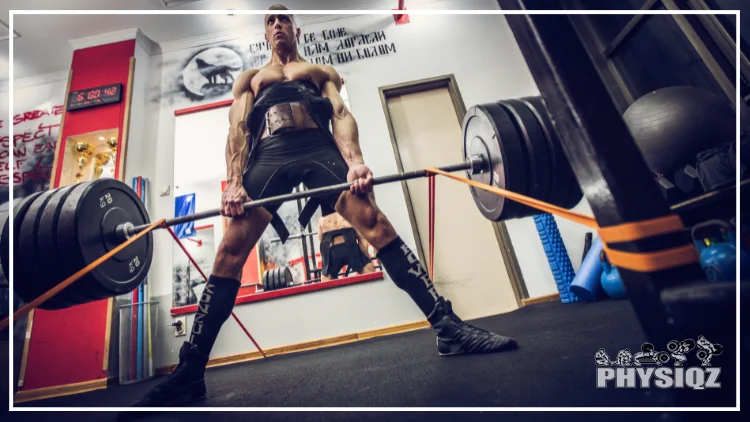
Deadlift accessory exercises can help address weaknesses and sticking points (where form breaks down, or the weight slows down) that hold back lifers back.1
That being said, these 14 accessory exercises have been tried and tested by many elite bodybuilders and powerlifters to build on technique and address deficiencies to increase and enhance their deadlifts.
Or in other words, they’re superior in providing enormous strength and muscle building while providing a stable platform for other exercises.
See this chart below to determine which exercises are best for you to correct any inadequacies in the deadlift such as being slow off the floor, or having difficulty with the lock out.
When To Do Deadlift Accessory Work & Why It Should Be Programmed
Accessory work is often neglected by many lifters because it is assumed to get better at deadlifts, more deadlifting is required.
While this is true, training hard and heavy will often bring to light weak points such as sticking points and muscle imbalances that will eventually halt progress in deadlifts.
Here are the reasons why deadlift accessory work should be programmed into any lifter who is serious about making gains:
Lack of proper technique—When performing deadlifts, it’s important to follow specific cues and techniques, such as maintaining good form by keeping a neutral back, retracting shoulders, using a moderate stance width, avoiding an overly wide grip on the barbell, positioning hips correctly, keeping knees outward, and keeping the bar close to the torso along the shins.2
Often, this compromises the start position.
When a lifter has sticking points—Sticking points are areas in the movement where the lifter has difficulty lifting the weight past a certain point. They can be at any part of the range of motion due to weaknesses in muscle groups.
Low speed off the floor—When a lifter lifts the load slowly off the floor, it means that they lack efficient technique in the start position and / or the muscles needed to generate force off the floor are not fully developed.
Lack of flexibility in the starting position—Having good flexibility is essential for the lifter to put themselves in a full range of motion and allows them to have a better starting position.
Tight hip flexors will result in the weight shifting to the toes which will make the initiation of the deadlift with a weight shift that is forward.
Weak deadlift lockout—Deadlift lockouts occur at the top of the movement and are just as important as the starting position. Weak lock outs are a result of not being able to get the shoulders back and a failure to bring the pelvis ‘through’ to lock the torso and complete the movement.
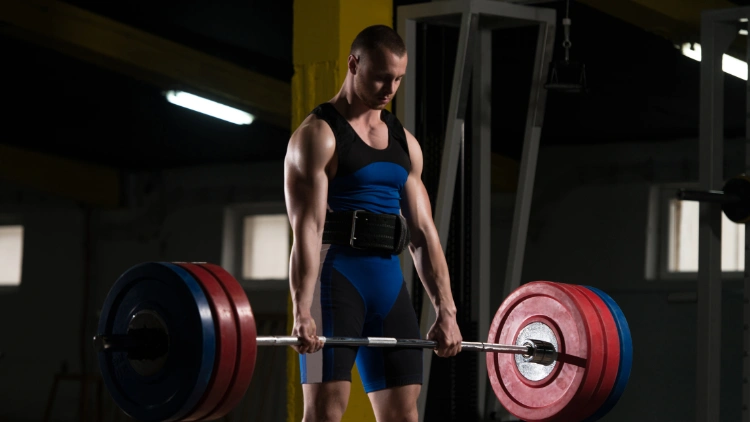
Source: Ibrakovic via Canva.com3
It is usually as a result of poor technique at the start, weak glutes and grip.
Weaknesses That Call for the Use of Deadlift Accessories
The aforementioned reasons are typically caused by weaknesses in muscle groups that are involved in the movement such as having weak glutes, hamstrings, back and grip strength.
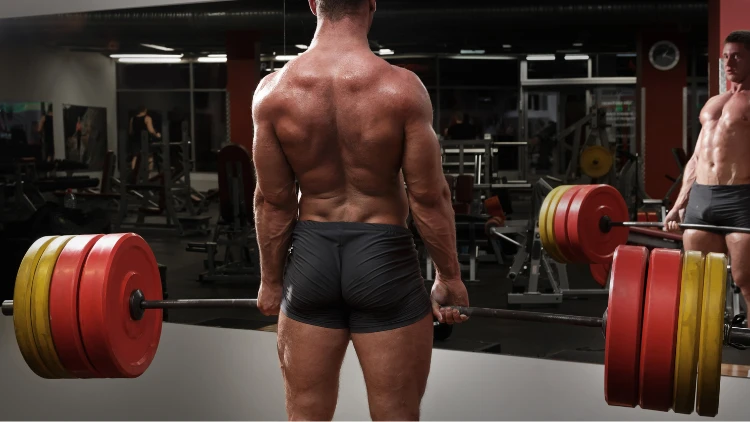
Source: Jun via Canva.com4
Weak glutes—Weak glutes will often be the culprit in causing stalls in the finishing part of the movement during the lockout. It will also cause fatigue in the first two parts of the deadlift which are when the bar is being lifted off the floor and second, when the bar is going past the knees.
Often, lifters with weak glutes will end up hyper extending their backs at lock out instead of activating their glutes.
Weak hamstrings— When the bar is passing the knees and the initiation of the raising of the torso commences, there is a transition of actions—from knee extension to hip extension.
This requires activation of the hamstrings, one of the key muscles you should feel during deadlifts; weakness in this area often causes the weight to shift forward, away from the torso.
Weak back—A weak back can cause a failure at lockout. When the lifter maintains a tight back throughout the movement, the bar will need to travel through a slightly longer ROM but the alternative is worse—thoracic rounding which is unsafe and prevents a proper lockout.
Weak grip—Deadlifts require superior grip strength. A lifter cannot deadlift effectively without a strong grip, regardless of grip style, whether hook grip or mixed grip.
Even hook grips that don’t demand strong forearms are of no use if the overall grip is weak. Weak grip is typically the culprit cause of losing the bar during the movement and leading to an incomplete and poor lockout.
Lack of bracing—Bracing is imperative in deadlift as it serves as the function to stiffen the core muscles, to maintain a neutral and straight spine and prevent any spine flexion. The spine was designed to handle compressional and not shearing forces which could cause injury.
Poor bracing due to a weak core prevents the other muscles involved in the lift from properly executing.
Weak quads—Weak quads are not particularly the reason why many lifters fail at deadlifts, particular in the conventional stance due to the quads being strongest in the starting position. Quads that are weak may be a reason why the bar may stick to the floor especially in sumo deadlifts.
Weak hips—Hips play the primary role in the hip hinge which is at the heart of the deadlift. Hip hinge is bending the body downwards in half while the pelvis, thoracic and lumbar spine remain fairly static.
When the hips are weak, they become a chink in the armor and cause something else to fail such as the back, grip and core muscles resulting in a failure to finish the lift.
14 Deadlift Accessory Exercises
Fortunately, lifters should see and use this chart that has 14 accessory exercises for deadlift that have been shown to increase deadlift performance. These have been tried and tested by many powerlifters and bodybuilders and will help reinforce techniques and strengthen the muscle groups that result in poor form.
These include:
- Deficit deadlift
- Glute bridge
- Hip thrust
- Romanian deadlift
- Snatch grip deadlift
- Trap bar deadlift
It should be noted that a lifter does not need to do all the exercises below within the same program. They should perform a self-diagnosis where they are weakest in the ROM either due to poor technique and/or having sticking points and then choose exercises to address that.
1. Deficit Deadlift
The deficit deadlift is a variation of the conventional deadlift that is executed from a surface that is elevated, resulting in the bar being at a lower starting point that is normal. Conventional stance calls for a deficit in the region of 2-4 inches, while a sumo deadlift requires a smaller deficit at 1-2 inches.
As a result of the deficit, the muscles that are required for the bottom part of the movement have to work harder to overcome the load, enhancing the lifter’s maximal weight off the ground.
Use and benefits of the deficit deadlift: Deficit deadlifts are a bottom end accessory exercise that can:
- Improve the lifter’s speed off the floor.
- Increase hip and leg strength.
- Strengthen the lower back.
- Improve a lifter’s flexibility in the starting point of the deadlift.
How to do deficit deadlift: Due to a focus on the lower back, deficit deadlifts are typically trained using powerlifting belts to help give stability to the torso due to the increased ROM.
- Setting up the deficit deadlift will begin with the lifter standing on weight plates and /or blocks.
- They should then proceed to drop the hips into the initial position which will be lower than the conventional deadlift.
- Initiate the movement by pushing the floor away using knee extension.
- The lifter should take care not to shoot their hips too quickly which may be a natural inclination due to the deficit.
- Tension should be constantly maintained in the quads throughout the whole movement.
Muscles emphasized in deficit deadlift: The deficit deadlift works the glutes, hamstrings, lower back, erector spinae (muscles that line the spine), calves, lower and upper back. It places an emphasis on the lower back and hamstrings.
Set and rep range of deficit deadlift: Due to the additional ROM, this variation of deadlift is taxing and therefore the load used should be 10% of what a lifter usually uses in their regular deadlifts. They can maintain the same number of reps and sets as they do with the conventional deadlifts.
It’s advisable for the lifter to avoid squatting and deadlifting on the same day unless they start with heavy deficit deadlifts and follow up with lighter squats.
2. Glute Bridges
Glute bridges are a great accessory for the lower body and activate the glutes and core muscles. They help cure inactivity in the glutes, tightness in the back and back pain that results.

Source: avdeev007 via Canva.com5
Use and benefits of the glute bridges: Since glute bridges strengthen the glutes, they will help the lifter in areas of weakness where glute activation is most required like the lockout in the top part of the movement where hip extension occurs.
How to do glute bridges:
- The lifter should start by laying on their back and set their knees shoulder width apart, with bent knees and feet flat on the floor. The toes should be pointed forward, heels about 7 inches from the glutes. Arms should be flat with open palms facing upwards. For added resistance, a lifter can employ the use of dumbbells.
- Initiate the movement by slowly raising the hips by activating the glutes and engaging the abs and core muscles.
- The back should not be arched while raising the hips; at the top of the movement, the torso should be straight from shoulders to the knees. Glutes should be squeezed tightly here and held for 1-2 seconds.
- Complete the movement by lowering hips down in a controlled manner ensuring tension is maintained in the glutes and abs.
Muscles emphasized in glute bridges: Glute bridges engage the gluteus maximus mostly but due to hip extension, this exercise demands from the hamstrings with the transversus abdominis of the core muscles being also engaged in the exercise.6
Set and rep range of glute bridges: When these are performed with bodyweight, 15-25 reps of 3-4 sets should suffice.
3. Hip Thrust
The hip thrust is a popular glute strengthening movement which employs the use of a barbell that is placed at the crease of the hips with the lifters back to the bench and hips driven forward.
Hip thrusts provide a significant activation of the extensor muscles when compared to other regular exercises and the sequence of muscle activation follows the order of gluteus maximus, erector spinae, hamstrings, and quadriceps.7
Use and benefits of the hip thrust: The hip thrust, which also serves as a stiff leg deadlift alternative, is an excellent exercise for enhancing lockout strength by targeting the glutes, which play a crucial role in hip extension during this phase of the movement.
How to do hip thrust:
- The lifter should place a barbell loaded with a weight on the crease of their hip.
- They should then place their back against a bench to ensure that it is stable.
- Feet should then be placed such that the knees form a 90 degree angle.
- Initiate the movement by driving through the heels and raise the hips.
- Slowly lower back in a controlled movement to the starting position.
Muscles emphasized in hip thrust: The primary focus of the hip thrust is the gluteus maximus, and other secondary muscles include the erector spinae, hamstrings and quadriceps.
Set and rep range of hip thrust: Since the goal is to strengthen the glutes, the rep ranges should be low with a heavy weight where the lifter can perform 6-10 reps completing 3-5 sets; the lifter should get to the end of the reps with reps in reserve (RIR) of 1 or 2.
Reps in reserve is the number of reps that a lifter has left before reaching technical failure. Hip thrusts should not serve as a replacement of the deadlift and should be programmed right after a deadlift routine.
4. Romanian Deadlift
The Romanian deadlift is a variation of the deadlift where the starting position has the lifter standing and as a result, it places more focus on the glutes and the hamstrings but has a lower activation of the erector spinae muscles.8
This movement demands that the lifter pushes their hips back as they lower the barbell resulting in the shoulders being placed further in front than they would in the conventional deadlift. The ROM is lower as the bar will travel to just below the knee cap, before returning to the standing position and since the bar never touches the ground, there is an increased time under tension.
Use and benefits of the Romanian deadlift: Romanian deadlifts allow the lifter to strengthen and grow both glutes and hamstrings if performed in a higher rep range. It will help improve overall technique in mastering the hip hinge which many new lifters struggle with.
Most importantly, this movement will help the lifter improve their lockout. Since the hamstrings will get stronger, the likelihood of injuries to this muscle are reduced due to the lifter having more strength and control at their disposal.
How to do Romanian deadlift:
- While the weight is on the rack, lift it out and get into a standing position.
- The lifter should slightly bend at the knees and then perform the hip hinge lowering the bar to the knee.
- There should be conscious effort about having the weight on the heels and having and driving the hips as far back is possible.
- Ensure that the barbell remains on the thighs and that the shoulders are moving over the bar.
- When the barbell has reached slightly below the knee, squeeze the glutes while driving the hips forward.
- The knees should not be extended at the top but have a slight bend.
Muscles emphasized in Romanian deadlift: The gluteus maximus and hamstrings are the main muscles emphasized which places it among the best deadlift for glutes exercise and it also doubles as an efficient leg accessory exercise.
Set and rep range of Romanian deadlift: Romanian deadlifts are not an overload type of movement where heavy weight is used, despite it having a smaller range of motion. Lighter weight should be used with the focus to be on activating both the glutes and hamstrings during the eccentric (lowering the weight).
When it comes to a good deadlift weight for the Romanian deadlift, the recommended load to be used should be about 50% of the lifter’s 1 rep max (1RM) in their regular deadlift—the maximum weight that the lifter can perform in one rep.
They should be done at 6-12 reps in the 3-5 sets range and should be completed after a deadlift routine.
5. Single Leg Romanian Deadlift (Landmine)
Single leg Romanian deadlifts are an ideal accessory exercise due to the unilateral nature that addresses muscle imbalances that are masked during the deadlift. The lifter’s balance is put to the test on this movement and can be performed with either a barbell (landmine), kettlebell and/or dumbbells.
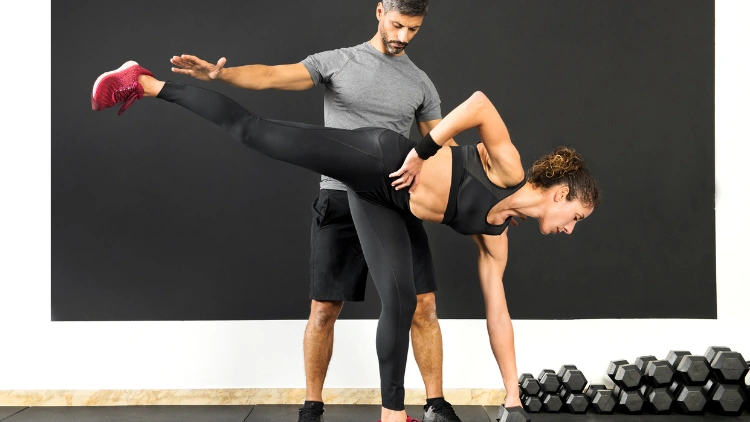
Source: Photology1971 via Canva.com9
The landmine variation offers the lifter a fixed bar path and long lever making it easier to balance and subsequently allow a heavier movement. As an added bonus, gripping the thick bar recruits the forearms muscles increasing grip strength.
Use and benefits of the single leg Romanian deadlift: The fixed bar path of the landmine variation and the heavier load a lifter can haul means that the hamstrings muscles are better activated. Just like the double leg variation, this will help the lifter master the hip hinge and develop superior glute strength for stronger lock outs.
How to do single leg Romanian deadlift:
- Place a barbell in a corner of a wall or in a landmine base and stand perpendicular to the barbell.
- The lifter should then hinge at the hip bending forward to grab the sleeve of the barbell and proceed to stand up.
- Maintain a slightly bent knee position to find balance and hinge until the body is parallel to the floor.
Muscles emphasized in single leg Romanian deadlift: Similarly to its double leg counterpart, single leg Romanian deadlifts emphasize the gluteus maximus and hamstrings.
Set and rep range of single leg Romanian deadlift: Perform 2-3 sets of 5-10 reps for each leg.
6. Snatch Grip Deadlift
Snatch grip deadlift is a wide grip deadlift where the hands are set up outside the hash marks of the barbell. As a result of the grip position, the torso is forced to be more slightly more parallel to the floor subsequently placing increased engagement of the glutes, grip and mid and lower back muscles.
Use and benefits of the snatch grip deadlift: Snatch grip deadlifts are deadlift assistance exercises that help prevent the back of a lifter from rounding (torso flexion) by building stable spinal strength.
How to do snatch grip deadlift:
- The lifter should establish their stance with a wider grip than their conventional deadlift on or outside the hash marks.
- Deadlift the bar up close to the torso while engaging the lats.
- Hips should be low with the shoulders just a tad in front of the barbell and drive the top position ensuring there is no rounding of the back.
Muscles emphasized in snatch grip deadlift: This variation of the deadlift will help strengthen and develop muscles of the posterior chain (muscles on the backside which include calves, hamstrings, gluteus maximus, lats and erector spinae).
Set and rep range of snatch grip deadlift: The same set and rep ranges the lifter uses on their conventional deadlift can be applied here with a 15% less load than what they would on the regular deadlift.
7. Trap Bar Deadlift
Trap bar deadlift is the same as the conventional deadlift in its movement, but instead of using a barbell, the lifter uses a trap bar which is also known as a hex bar and diamond bar.
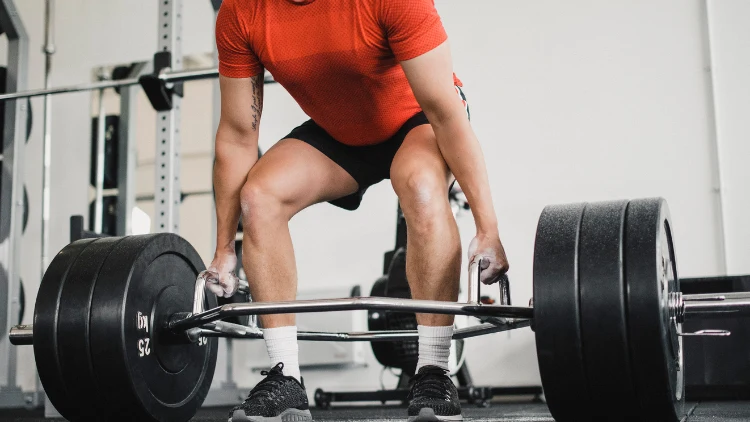
Source: SolStock via Canva.com10
The trap bar is a contraption that has the lifter stand within a closed box like frame allowing the weight plates to be directly lateral to the torso thereby placing the lifter in a more upright position.
This results in an increased engagement of the quad muscles and less stress on the spinal column.11
Use and benefits of the trap bar deadlift: Using the trap bar trains the lifter to get into the proper position in the deadlift by providing more leeway to manipulate the body based on their anatomies and levels of mobility. It emphasizes the quads and can be a viable accessory if they are the weak link in the armor.
How to do trap bar deadlift:
- The lifter should place themselves within the confines of the trap bar with the same stance as they would in the conventional deadlift.
- Proceed to grab the handles evenly although some lifters may have a rearward orientation.
- Drive and press the feet into the floor which will pull the weight upward and the lifter should maintain the torso position. Rounding of the back almost never happens in this variation which makes it ideal for mastering proper technique.
Muscles emphasized in trap bar deadlift: The muscles targeted in the trap bar deadlift include the quads, as well as muscles in the posterior chain, lower back, and hips.
Set and rep range of trap bar deadlift: This variation feels easier to do than conventional deadlifts, and as a result lifters can often lift heavier in trap bar than conventional deadlifts.12 Lifters should start using a load that is 10% heavier than what they would with the conventional variation and build from there performing for example, 5 reps for 5 sets.
8. Rack Pulls
Rack pulls also known as rack deadlifts have the bar set up on safety pins inside the squat and/or power rack. By having a higher starting position, there is a focus on the top end of the range of motion.
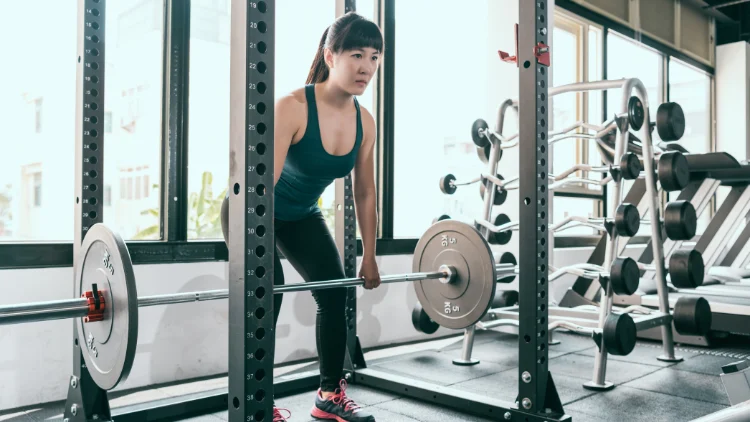
Source: PRImageFactory via Canva.com13
This deadlift accessory exercise is itself a partial ROM because the safety pins prevent the lifter from bringing the barbell back to the floor. Position of the pin placements typically has the bar travel between to just below the knee to slightly above the knee cap.
Use and benefits of the rack pulls: Due to the priority being load rather than ROM, rack pulls focus on the top end of the movement thus helping improve and strengthen the lifter’s deadlift lockout. In addition it improves the grip strength and increases upper and lower back strength.
How to do rack pulls:
- Set the safety pins inside the power rack such that the barbell is at knee height.
- Shoulders should be positioned to align with the barbell.
- Before initiating the pull, the lifter should squeeze their hands and activate their lats before forcefully driving the hips towards the bar.
- As they approach lock out, the lifter should retract the shoulders and squeeze the glutes.
- Place the barbell back to the pins bringing it to a halt before repeating.
Muscles emphasized in rack pulls: Racks pulls place more emphasis on back extensor muscle groups which include erector spinae muscles of the lower back and gluteal muscles (gluteus maximus, gluteus minimus and gluteus medius). It is acceptable to use lifting straps here if the grip eventually fails as it is heavily challenged.
Set and rep range of rack pulls: Lifters can haul more weight with this variation due to the partial ROM and as a result, lifters can on average expect to lift 5-15% more than when deadlifting. Range of reps will vary depending on how pins have been set.
Since the lifter is looking for strength, they should do 2-4 sets for 12-15 reps. For those that are already strong in this part of the ROM, mass may be the goal and can target 3-5 sets for 6-8 reps.
9. Slow-to-The Knee Deadlift
This type of deadlift has the lifter initiate the pull off the ground in a slow fashion taking about 3 seconds to do, and then once the bar is at the knee, pulling it explosively into lock-out.
This exercise will likely require the use of a metronome (device that produces a steady pulse) that allows them to be consistent across all the reps by allowing them to properly keep tabs on the time.
Use and benefits of the slow-to-the-knee deadlift: This exercise helps lifters to be ‘patient’ off the floor—lifters often fail and forget to pull the slack out the barbell (to compensate for the tiny space between where the bar sits on the ground and where the plates are on the barbell) which may have the lifter shoot out of this bottom position.
When this happens, the lock out is usually compromised.
How to do slow-to-the-knee deadlift:
- The lifter sets this up like a conventional deadlift.
- Ensure to take the slack out of the barbell when hips are set.
- While lifting the weight off the floor, cue to push the floor slowly away and the bar should reach the knees in 3 seconds.
- Ensure that the torso angle is maintained and barbell on the shins, when at the knee, explosively pull shoulders back and move the hips forward.
Muscles emphasized in slow-to-the-knee deadlift: This variation emphasizes the traps, spinal erector, glutes and hamstrings.
Set and rep range of slow-to-the deadlift: A light load should be selected here, lifter should be looking at weight that is 60%-70% of the 1RM aiming for 4-6 sets for 3-5 reps.
10. Bent Over Rows
Bent over rows are a compound movement that place the body in an isometric hip hinge. This means that the hip hinge is performed in a state of static muscle contraction unlike the deadlift where the hip hinge is being performed dynamically.
Use and benefits of the bent over rows: As a result of the isometric hip hinge, holding this position will place the lower and upper back in a state of increased time under tension which builds endurance.14 Bent over rows also help strengthen and improve grip strength and help the lifter master the hip hinge technique.
By building a stronger back, they will be able to better maintain tension throughout the deadlift and have a better lockout.
How to do bent over rows:
- While hinging at the hips, grab a barbell with an appropriate weight with a grip that is slightly wider than shoulder width.
- Squeeze shoulders blades together and commence to row the bar ensuring that it touches the stomach.
- The elbows should be angled at approximately 45 degrees throughout the movement.
- When in the top position, hold briefly and slowly lower the weight in a controlled motion back to the starting position.
Muscles emphasized in bent over rows: Emphasizes upper and lower back, lats and to a lesser extent the shoulders and biceps.
Set and rep range of bent over rows: The ideal rep range to build strength and mass would be performing 6-12 reps in the 4-6 sets range.
11. Banded Deadlift
Banded deadlift is a conventional deadlift in every sense of the word, with the exception that a resistance band is attached to the barbell which creates additional tension. When the lifter pulls the load off the floor, the additional resistance will make the top of the movement much more challenging when compared to the bottom.15
Use and benefits of the banded deadlift: This type of deadlift provides two benefits for the lifter: they help them learn how to accelerate the barbell through the full ROM; there is no ‘slacking’ in how much force they produce in any part of the ROM as they simply apply full power throughout.
Secondly, banded deadlifts will help build lock out strength.
How to do banded deadlift: This deadlift is done the same way as a conventional deadlift with the exception of having the resistance band loop around the barbell and placed below the feet that act as an anchor.
The resistance bands provide approximately 10-35 lbs. of extra tension at the top assuming the lifter is using ½ inch band.
Muscles emphasized in banded deadlift: Banded deadlifts just like the conventional deadlifts emphasize primarily the muscles of the posterior chain.
Set and rep range of banded deadlift: Load is typically kept between 60%-80% of the lifter’s conventional 1RM and they should perform 4-6 sets of 1-5 reps.
12. Good Mornings
Good mornings are a compound exercise that employ the use of a barbell and allow the hamstrings and glutes to go through a longer ROM making it a viable option to develop and strengthen these muscles.
Due to the nature of the movement, good mornings are great at helping lifters hone their technique at the hip hinge and help strengthen the lower back and the spinal stabilizers such as the erector spinae. They can also be enhanced by adding a horizontal resistance band.
Use and benefits of the good mornings: Good mornings have a myriad of benefits including helping the lifters maintain proper form while performing the hip hinge thus improving their overall deadlifting technique. They also help prevent lifters from flexing their spines during deadlifting due to weak back muscles.
Since good mornings put the hamstrings through a longer ROM in the eccentric, the hamstrings are put into a significant stretch preventing hamstrings injuries.16
How to do good mornings:
- The lifter should position themselves under a loaded barbell, using the same setup as they would for back squats, and then walk out with the bar resting on the upper back’s trap muscles.
- Slightly bend at the knees and hinge at the hips to the point where the torso is parallel to the floor.
- Return to the starting position by engaging and contracting the glutes and hamstrings for completion of one rep.
Muscles emphasized in good mornings: Good mornings target and strengthen the gluteus maximus and hamstrings muscles.
Set and rep range of good mornings: Perform 8-12 reps in 2-3 sets.
13. Pendlay Row
Pendlay rows are a compound movement that engage the upper back muscles including the traps, rhomboids and lats. It is similar to bent over rows but is performed with a much wider grip and the bar is always reset on the floor between the reps while keeping the torso in a rigid state.
The bar reaches the sternum in this movement as opposed to the stomach in bent over rows.
Use and benefits of the pendlay row: Pendlay rows train the lifter to overcome weaknesses in keeping the bar close to the torso in the deadlift, generally attributed to having weak lats.
How to do pendlay rows:
- With the barbell in front of the lifter, grab the barbell using a wide grip similar to that of the bench press.
- Maintain the torso such that it is parallel to the ground and pull the barbell to the sternum.
- Return the barbell back to the floor making sure it comes to a dead stop and repeat the movement.
Muscles emphasized in pendlay rows: Pendlay rows emphasize the muscles of the back, mainly the lats and the rhomboids.
Set and rep range of pendlay rows: These exercises should follow a deadlift workout and can be done in 4-6 sets, with each set consisting of 5-10 reps using a weight that allows the lifter to maintain proper form.
14. Front-Rack Bulgarian Split Squat
Bulgarian split squats are another unilateral exercise on this list that can improve the deadlift by building on leg drive due to a larger range of motion. The quads, and particularly the glutes, are heavily recruited in this movement more so than in the back squat.17

Source: Victoria Gnatiuk via Canva.com18
The upper back and core are strengthened by this exercise and it also enhances hip mobility of the lifter.
Use and benefits of the Bulgarian split squat: The first logical benefit is that Bulgarian split squats reduce muscle imbalances which ultimately improves the leg drive and more leg muscle recruitment.
This is a result of the need for balance and since the weight is in a front rack, stronger core and upper back muscles are needed which translates into a neutral spine when under heavy compression from deadlifts.
How to do Bulgarian split squats:
- Using a pair of kettlebells and / or placing a barbell on the clavicles of the shoulders similarly to a front squat, hold the chest up and maintain shoulders retracted and place the back foot on a bench and adjust it to an ideal position.
- Lower into a split squat by taking the back knee towards the ground and ensure to maintain a slightly forward lean.
- Use the front foot to drive through the floor to return to the starting position.
Muscles emphasized in Bulgarian split squats: The quads and glutes are the main focus but the hamstrings, abductor muscles, abdominals and calves are also used.
Set and rep range of Bulgarian split squats: Start by doing 2 sets of 6-8 reps per leg using only body weight. Once the lifter is able to complete 12 reps in 3 sets, they can then incorporate additional weight using barbells, kettlebells or dumbbells.
What Are the Best Accessories Meant To Mitigate Deadlift Back Rounding?
Back rounding in deadlift is usually a result of having a weak back, therefore exercises that can help mitigate this are those that will strengthen these muscles. These include:
- Snatch deadlift
- Trap deadlifts
- Pendlay rows
- Deficit deadlift
How Often Should I Perform Deadlift Accessory Exercises?
Deadlift accessory exercises just like deadlifts take a toll on the body and when combining the two, it can easily lead to overtraining and set up for injury or even make the lifter reach training plateaus (where they are no longer making any muscle gains).
Therefore it is imperative to ‘cycle’ through deadlift accessories every 4-8 weeks to prevent these issues from creeping up.
Tips & Cues to Deadlift Heavy & Safely
Deadlifting with correct technique such as keeping the bar close and perfect form including not rounding the back will not only produce massive force that will lead to gains in both strength and mass, it will allow the lifter to lift heavy and do so in a manner that is safe while reducing the risk for injury.
Here are some tips and cues to deadlift heavy and safely:
- Keep the back straight and neutral, using leg drive to get the weight up.
- Do not go too deep on the deadlift, most power from the legs comes when they are at parallel.
- Keep the bar as close to the torso as is possible.
- Always engage the core and take the slack out of the bar before lifting.
- Perform a static hold at the last rep of the routine to reinforce proper form.
- Massively improve the deadlift by going heavy on back squats.
- Use correct deadlift gear including shoes and lifting straps.
- Always make sure to be fuelled for the lift and not do it on an empty stomach.
Alongside these tips, you can follow 10 cues for deadlift setup perfection to ensure a heavy and safe deadlift.
Common Mistakes To Avoid When Deadlifting and/or Performing a Deadlift Accessory
There are a number of common mistakes that rookie and novice lifters perform when deadlifting and the associated accessory movements which lead to inefficient lifts and putting them at risk for injuries.
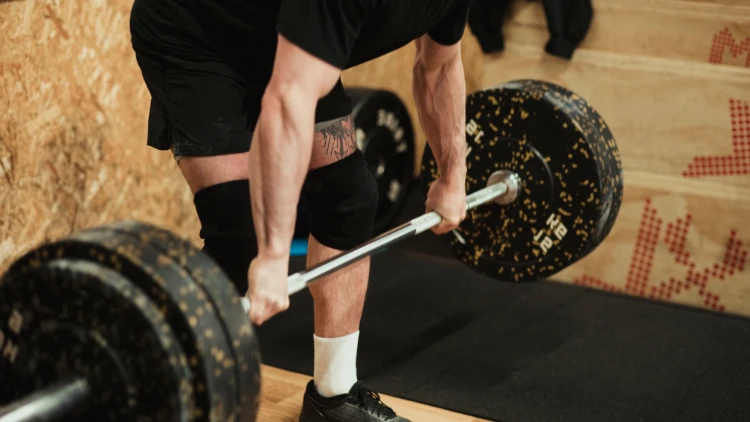
Source: SolStock via Canva.com19
These include:
- Rounding the lower back when pulling the bar.
- Losing grip of the bar.
- Poor and incomplete lock out at the top movement.
- Hips rising faster than the shoulders during the ascent.
- Bar moving away from the shins and legs.
- Challenges in breaking the bar way from the floor.
- Sticking points at any part of the range of motion and in particular, past the knees.
- Lack of constant tension through the lift.
What Deadlift Accessory Products Should a Lifter Use When Deadlifting?
Lifters can use deadlift accessory products to make their workouts more efficient due to emphasis placed on muscles such as lower back muscles or when grip is failing while the back still has the strength to continue the workout.

Source: Maridav via Canva.com20
Accessory equipment includes:
- Powerlifting belt—This will give support to the lower back and stabilize the torso especially when lifting heavy. Brands such as Hawk Sports, Iron Bull Strength Powerlifting Lever Belt, Rogue Leather Lever Belt, are ideal for this.
- Lifting straps—Grip strength typically goes out before the back muscles. Using lifting straps can help the lifter go for more. Harbinger straps are an excellent brand.
- Deadlift shoes and slippers—Lifters who choose to deadlift can do so barefoot, but if they prefer wearing shoes, it’s recommended they use specialized deadlift shoes like Adidas powerlifting shoes for optimal stability and minimal sole compression. Alternatively, lifters may consider deadlift slippers, which offer even better performance than shoes.
- Knee sleeves—Consider getting knee sleeves because they enhance knee protection by securing and stabilizing the joint.
- Deadlift shin guards—These will help protect the shins if a lifter is in shorts, since the bar typically scraps against the shins.
- Wrist wraps—Wrist wraps, commonly used in bench presses, aid in finger flexion to assist lifters in maintaining their grip during heavy lifting, such as during a powerlifter’s deadlift.
How To Use a Deadlift Accessory To Increase Deadlift Weight Pulled
The main goal and objective of deadlift accessories is to target the lifters weaknesses in the deadlift exercise which in of itself is a complex movement to thus increase deadlift performance. These accessories should be used to target the hamstrings and gluteus muscles, two primary pillars in the posterior chain that often render lifters to have weaknesses in varying areas of the ROM of the deadlift.
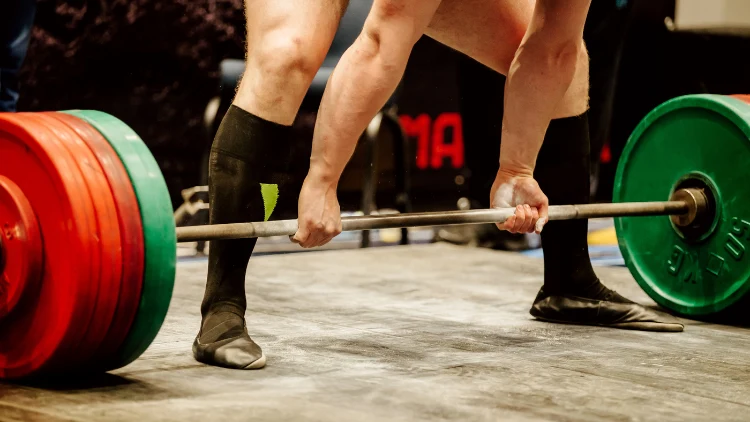
Source: sportpoint via Canva.com21
Since many of the accessories target almost similar weaknesses such as the hip hinge and/or lockout, lifters should cycle between the exercises to help avoid boredom and plateauing. These accessories can contribute to daily undulating periodization by introducing varied stimuli when incorporated into a deadlift program.
In addition, since the accessory work is adding more strain to the muscles, lifters should ensure that they are getting adequate rest such as regularly taking 3 days rest from back and lower body work. This will allow sufficient recovery in between sessions to regain strength levels and prevent overtraining.
Deadlifts are a one of the 3 compound lifts that give the lifters superior mass gains and strength, but often lifters end up having weaknesses in various parts of the movement due to muscle weaknesses, poor technique and form.
Including a deadlift accessory program into your deadlift regimen will go a long way to resolving these inadequacies and these 14 accessory exercises have been shown to consistently increase the deadlift the most—so be sure to review the chart to see which exercises are best suited for your specific weaknesses.
Frequently Asked Questions
Are Dumbbells the Best for Strengthening Your Back?
Dumbbells may not necessarily be the best for strengthening the back, but they are certainly an excellent and useful tool for growing the back muscles. Dumbbells allow for a greater range of motion and open up the body to the row movement and are great for targeting the lats.
As they are unilateral, they allow the lifter to address muscle imbalances.
What Exercises Can Be Used to Superset Deadlifts?
There are a number of exercises that can be used to superset deadlifts—these types of supersets are minor exercises that will work similar muscle groups as the deadlift and they include bent over rows, chin ups, lying hamstring curls and walking lunges. They can also be done with antagonist movements that do not involve compression similarly to deadlifts, such as dips which are a decompression movement.
Supersets provide a viable way for the lifter to harden muscles.
What Unilateral Exercises Can Be Used As Deadlift Accessories?
Unilateral deadlift accessory exercises would incorporate the use of barbells and/ or dumbbells to address muscle imbalances in the deadlift and these include single leg Romanian deadlift and the Bulgarian split squat.
Can You Squat and Deadlift the Same Day?
This depends on your training goals; but it is possible to squat and deadlift the same day if the objective of the training is to increase strength and endurance. If the objective is muscle growth, the lifter cannot go heavy on both exercises if they are completed the same day as they are both taxing.
Performance in the second exercise that follows when done on the same day will more than likely be compromised since the muscles will be exhausted.
What Deadlift Accessories Are Done off the Floor?
Deadlift accessories done off the floor are those done with the barbell being lifted off the ground; these include deficit deadlifts, interval deadlifts, slow-to-the knee deadlifts, trap bar deadlifts, snatch grip deadlifts and banded deadlifts.
What Are the Deadlift Accessories for Powerlifting?
Deadlift accessories that are for regular bodybuilders would also suit powerlifters as well and they include glute bridges, deficit deadlifts, hip thrusts, rack pulls, good mornings, bent over rows, banded deadlifts and single leg Romanian deadlifts.
Are Sumo Deadlifts Accessory Exercises the Same As Conventional Deadlifts?
Sumo deadlifts have different accessory exercises as the ones done for conventional deadlifts—these include front squats to a low box, sumo deadlift done with a one inch deficit, rackable cambered good mornings and stiff leg sumo deadlifts. However, there are other accessory exercises that are similar for both types, and these include conventional deficit deadlifts and Romanian deadlifts.
Can Deadlifts Make You Ripped?
Deadlifts are a full body workout that target the back muscles, the core, shoulder girdle while having an emphasis on the lower body muscles including the gluteus maximus, hamstrings and quads; as a result the movement will promote muscle growth resulting in an increase in lean mass in the upper and lower body.
They also help in weight loss since they do burn calories which results in a lifter being ripped after a while of using this exercise routine since there is less fat, thus improving muscle definition and tone. How many calories does deadlifting burn?
Someone weighing 170 lbs. deadlifting for 30 minutes can expect to burn roughly 230 kcal.
How Often Should You Deadlift?
Beginners and experienced lifters alike should target to deadlift 1-3 times a week allowing for sufficient recovery times between lifts. While it may be acceptable in some instances to deadlift more, like in cases where the lifter has reached training plateaus, there should be management on the intensity and volume in these cases.
How Many Sets & Reps of Deadlifts Should I Do Each Workout?
This depends on the objective of the deadlift workout that is being done for the day. On average, 3-5 sets of 3 to 6 reps of 70%-85% of the 1RM would suffice.
Lifters looking to achieve muscle growth can target 2-3 sets of 8-10 reps at 55%-70% 1RM. Those wanting to train for strength should perform 3-4 sets of 4-6 reps at 65%-75% of their 1RM.
Is It Okay to Superset Deadlifts With Another Exercise?
It is acceptable to superset deadlifts with other exercises, but it is always good practice to complete the deadlift sets before moving to the superset exercises due to the demand that the deadlift places on the central nervous system.
What’s the Best Exercise to Superset Deadlifts With?
The best exercise to superset deadlifts are parallel bar dips that provide a decompression movement to complement the compression offered by deadlifts.
Are Deadlift Accessory Exercises Necessary?
Deadlift accessory exercises are not a necessity. However, they are highly recommended to perform to improve deadlift technique and cure muscle weaknesses that render the deadlift movement inefficient.
References
1South_agency. Canva. Accessed 16 April 2023. <https://www.canva.com/photos/MAEJNTIgNdg-deadlift-exercise-in-gym/>
2Academy, A. F. (2017, January 18). DEADLIFT TECHNIQUE AND TEACHING POINTS. Retrieved 2023, from <https://www.fitnesseducation.edu.au/blog/education/barbell-deadlift-teaching-points-and-proper-technique/>
3Ibrakovic. Canva. Accessed 16 April 2023. <https://www.canva.com/photos/MADwNQVmzkE-powerlifter-man-deadlift-competition/>
4Jun. Canva. Accessed 16 April 2023. <https://www.canva.com/photos/MADDBxalmjA-strong-man-doing-deadlift/>
5avdeev007. Canva. Accessed 16 April 2023. <https://www.canva.com/photos/MAEJC1rwid8-hip-thrust/>
6BRIDGES, B. A.-L. (2017, August 12). B.J. Lehecka, Michael Edwards Ryan Haverkamp, Lani Martin, Kambry Porter, Kailey Thach, Richard J. Sack, Nils A. Hakansson. Retrieved 2023, from <https://www.ncbi.nlm.nih.gov/pmc/articles/PMC5534144/>
7Walter Krause Neto, T. L. (2019, June 1). Barbell Hip Thrust, Muscular Activation and Performance: A Systematic Review. Retrieved 2023, from <https://www.ncbi.nlm.nih.gov/pmc/articles/PMC6544005/>
8Isabel Martín-Fuentes, J. M.-L. (2020, February 27). Electromyographic activity in deadlift exercise and its variants. A systematic review. Retrieved 2023, from <https://www.ncbi.nlm.nih.gov/pmc/articles/PMC7046193/>
9Photology1971. Canva. Accessed 16 April 2023. <https://www.canva.com/photos/MADqcF-frmQ-woman-doing-a-single-leg-deadlift-in-a-gym/>
10SolStock. Canva. Accessed 16 April 2023. <https://www.canva.com/photos/MAEIyLw7cI8-deadlifting-in-the-gym/>
11EDWARD JO, K. A. (2022, March 1). Electromyographic Examination of Hip and Knee Extension Hex Bar Exercises Varied by Starting Knee and Torso Angles. Retrieved 2023, from <https://www.ncbi.nlm.nih.gov/pmc/articles/PMC9022700/>
12Paul A Swinton, A. S. (2011, July). A biomechanical analysis of straight and hexagonal barbell deadlifts using submaximal loads. Retrieved 2023, from <https://pubmed.ncbi.nlm.nih.gov/21659894/>
13PRImageFactory. Canva. Accessed 16 April 2023. <https://www.canva.com/photos/MADZ_-GXt3A-woman-doing-deadlift-in-the-smith-machine/>
14Chad M J Fenwick, S. H. (2009, March). Comparison of different rowing exercises: trunk muscle activation and lumbar spine motion, load, and stiffness. Retrieved 2023, from <https://pubmed.ncbi.nlm.nih.gov/19197209/>
15Vidar Andersen, H. P. (2020, November 5). Acute Effects of Elastic Bands as Resistance or Assistance on EMG, Kinetics, and Kinematics During Deadlift in Resistance-Trained Men. Retrieved 2023, from <https://www.ncbi.nlm.nih.gov/pmc/articles/PMC7739579/>
16Andrew David Vigotsky, E. N. (2015, January 6). Effects of load on good morning kinematics and EMG activity. Retrieved 2023, from <https://www.ncbi.nlm.nih.gov/pmc/articles/PMC4304869/>
17ETHAN R. MACKEY1, B. L. (2021, April 1). Biomechanical Differences Between the Bulgarian Split-Squat and Back Squat. Retrieved 2023, from <https://www.ncbi.nlm.nih.gov/pmc/articles/PMC8136570/>
18Gnatiuk, Victoria. Canva. Accessed 16 April 2023. <https://www.canva.com/photos/MADSXQlrPcA-young-woman-in-gym-sporty-lifestyle-total-resistance-workout-doing-bulgarian-split-squat/>
19SolStock. Canva. Accessed 16 April 2023. <https://www.canva.com/photos/MAEI2PJF5Hs-man-performing-a-deadlift/>
20Maridav. Canva. Accessed 16 April 2023. <https://www.canva.com/photos/MAEDP08dEbc-weightlifting-wrist-straps-fitness-man/>
21sportpoint. Canva. Accessed 16 April 2023. <https://www.canva.com/photos/MADI6pTZewY-performing-deadlift-man-powerlifter-competition-powerlifting/>